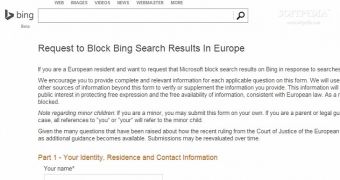Microsoft today started accepting “right to be forgotten” requests in Europe, allowing users who want to remove their names from search results displayed by Bing to contact the company with the help of an online form.
The company's new form, which can be found at this link, requires users to provide identity, residence, and contact information, as well as role in society or community, and pages that you want to block.
An upload option is also offered and Microsoft wants users to upload “one or more documents that verify your full legal name and your European country of residence,” which will be used to check your identity and determine whether you are indeed the one requesting the block.
Although this could raise additional concerns of privacy, Microsoft still gives users the possibility to “obscure any details on the documents that are not related to verifying your name, country of residence, or the validity of the document itself.”
Needless to say, the information you provide needs to be accurate and Microsoft says that every single detail that you include in the form will be closely checked by its staff.
“We encourage you to provide complete and relevant information for each applicable question on this form. We will use the information that you provide to evaluate your request. We may also consider other sources of information beyond this form to verify or supplement the information you provide,” the company says.
“This information will help us to consider the balance between your individual privacy interest and the public interest in protecting free expression and the free availability of information, consistent with European law. As a result, making a request does not guarantee that a particular search result will be blocked.”
Google is one of the first companies that launched a “right to be forgotten” form, saying that the amount of requests it received in the first months of availability was overwhelming. The company revealed earlier this month that approximately 70,000 takedown requests have been received since May when the form went live, with around 250,000 webpages included in these requests.
Microsoft is expected to receive a similar amount of requests in the coming weeks, but more information would be provided very soon, as the company is very likely to share such data with users.
We've also reached out to Microsoft for some comments on this and will update the article accordingly when we get an answer.

 14 DAY TRIAL //
14 DAY TRIAL //